Biodegradable metal alloy for anchoring detached tissue to hard tissue, method of making the same, and process for using the same
a metal alloy and metal alloy technology, applied in the field of biodegradable metal alloy for anchoring detached tissue to hard tissue, can solve the problems of cartilage damage, non-biodegradable materials being left in the body permanently, and affecting the assessment of medical images, so as to achieve high mechanical strength and the effect of being absorbed
- Summary
- Abstract
- Description
- Claims
- Application Information
AI Technical Summary
Benefits of technology
Problems solved by technology
Method used
Image
Examples
embodiment one
rmance Test
[0035]In this embodiment, the biodegradable metal alloy used is Mg—Zn—Zr alloy, ZK50 (Zn 5.0 wt %, Zr 0.5 wt %) and the sample has a diameter of 1.2 cm and a thickness of 0.4 cm. The ZK50 alloy was immersed in a 42% hydrogen fluoride (HF) solution and the solution with the alloy sample therein was shaken for 24 hours to form a magnesium fluoride (MgF2) coating for increasing the corrosion resistance. Refer to FIG. 2, the final product—MgF2—ZK50 with black coating (MgF2) is shown.
1. Corrosion Resistance Analysis
[0036]Electrochemical tests were performed for corrosion resistance analysis. The corrosion current density was determined by the potentiodynamic polarization curve. More specifically, potentiodynamic polarization tests were conducted at the scan rate of 0.001 V / s and the scan range of −2 V to −1 V. The test temperature was controlled at room temperature (about 25° C.) and the solution used was revised simulated body fluid (r-SBF). The electrochemical tests were per...
embodiment two
[0041]In this embodiment, the biodegradable metal alloy used is Mg—Zn—Zr alloy, ZK50 alloy (Zn 5.0 wt %, Zr 0.5 wt %). The metal alloy was processed by the computer numerical control (CNC) machine to get magnesium alloy anchors with proper size for being applied to New Zealand White rabbits' shoulders. Then the ZK50 anchors were immersed in a 42% hydrogen fluoride (HF) solution and the solution with the alloy anchors therein was shaken for 24 hours to form a magnesium fluoride (MgF2) coating on the anchor for increasing the corrosion resistance. The anchor produced is shown in FIG. 10 and the black coating (MgF2) on the surface thereof can not only stimulate bone growth but also improve corrosion resistance and degradation of Mg—Zn—Zr alloy. Then two non-degradable sutures were passed through the eyelet of the anchor for securing detached tissue to hard tissue.
[0042]In animal tests, magnesium alloy anchors made of biodegradable metal alloy MgF2—ZK50 and titanium anchors (Ti6Al4V) wi...
embodiment three
[0045]Refer to FIG. 13, the supraspinatus tendon of rotator cuff on shoulder joint of New Zealand White rabbit was fully cut and then was repaired and fixed to the original position by two sutures and Mason-Allen suture technique.
[0046]During animal testing, the recovery of rotator cuff repair in two groups implanted with magnesium anchor (MgF2—ZK50) made of biodegradable metal alloy and titanium anchor (Ti6Al4V) made of conventional titanium alloy, respectively after surgery was compared.
[0047]The tendon and bone tissues containing the anchor are harvested 1 month after surgery and 3 months after surgery, respectively, and the recovery of the tissues was observed. Refer to FIG. 14, computed tomography (CT) results showed that the biodegradable MgF2—ZK50 anchor remained intact after being implanted for 1 month. The implant showed good corrosion resistance at the beginning of implantation, the surrounding bone tissues regenerated quite well and attached to the anchor tightly. In cont...
PUM
| Property | Measurement | Unit |
|---|---|---|
| Fraction | aaaaa | aaaaa |
| Time | aaaaa | aaaaa |
| Strength | aaaaa | aaaaa |
Abstract
Description
Claims
Application Information
 Login to View More
Login to View More - R&D
- Intellectual Property
- Life Sciences
- Materials
- Tech Scout
- Unparalleled Data Quality
- Higher Quality Content
- 60% Fewer Hallucinations
Browse by: Latest US Patents, China's latest patents, Technical Efficacy Thesaurus, Application Domain, Technology Topic, Popular Technical Reports.
© 2025 PatSnap. All rights reserved.Legal|Privacy policy|Modern Slavery Act Transparency Statement|Sitemap|About US| Contact US: help@patsnap.com



